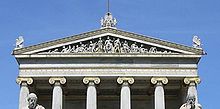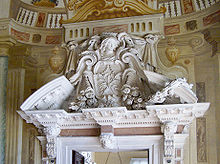- Pediment
-
 The upper part of the Greek National Academy building in Athens, showing the pediment with sculptures
The upper part of the Greek National Academy building in Athens, showing the pediment with sculptures
A pediment is a classical architectural element consisting of the triangular section found above the horizontal structure (entablature), typically supported by columns. The gable end of the pediment is surrounded by the cornice moulding. The tympanum, or triangular area within the pediment, was often decorated with sculptures and reliefs demonstrating scenes of Greek and Roman mythology or allegorical figures.
Contents
History
The pediment is found in classical Greek temples, renaissance, and neo-classical architecture. A prominent example is the Parthenon, where it served as a palette for intricate sculptural detail. This architectural element was developed in the architecture of ancient Greece. In Ancient Rome, the Renaissance, and later architectural revivals, the pediment was used as a non-structural element over windows, doors and aedicules.
A variant is the "segmental" pediment, where the normal angular slope of the raking cornice is replaced by one in the form of a segment of a circle, in the manner of a depressed arch. Both traditional and segmental pediments have "broken" and "open" forms. In the broken pediment the raking cornice is left open at the apex.
The open pediment is open along the base – often used in Georgian style architecture. A further variant is the "Swan-necked" pediment, where the raking cornice is in the form of two S-shaped brackets. The decorations in the tympanum can extend through these openings, enriched with "Alto-relievo" sculpture, "tondo" paintings, mirrors or windows. These forms were adopted in Mannerist architecture, and applied to furniture designed, or inspired, by Thomas Chippendale.
Some experts define "open pediment" and "broken pediment" as being the same thing.[1]
Significant pediments in the United States
- Apotheosis of Democracy at the United States Capitol, Washington D.C.
- United States Supreme Court building, Washington D.C.
- National Archives Building, Washington D.C.
- Wisconsin State Capitol, Madison, Wisconsin
- Wayne County Building, Detroit, Michigan
- New York Stock Exchange Building, New York City
- San Francisco City Hall, San Francisco, California
- Missouri State Capitol, Jefferson City, Missouri
- Philadelphia Museum of Art, Philadelphia, Pennsylvania
- Severance Hall, Cleveland, Ohio
See also
- Gable
- Temple (Greek)
- Temple (Roman)
Notes
- ^ Harris, Cyril M., ed. ‘’Illustrated Dictionary of Historic Architecture, Dover Publications, New York, c. 1977, 1983 edition p. 386
References
- Dictionary of Ornament by Philippa Lewis & Gillian Darley (1986) NY: Pantheon
External links
 Media related to pediments at Wikimedia Commons
Media related to pediments at Wikimedia Commons Chisholm, Hugh, ed (1911). "pediment". Encyclopædia Britannica (11th ed.). Cambridge University Press.
Chisholm, Hugh, ed (1911). "pediment". Encyclopædia Britannica (11th ed.). Cambridge University Press.
Gallery
-
The Madeleine Church in Paris
-
Severance Hall, Cleveland, Ohio
-
The previous abbey palace in Saint-Hubert Belgium.
Categories:- Architectural elements
- Columns and entablature
Wikimedia Foundation. 2010.







